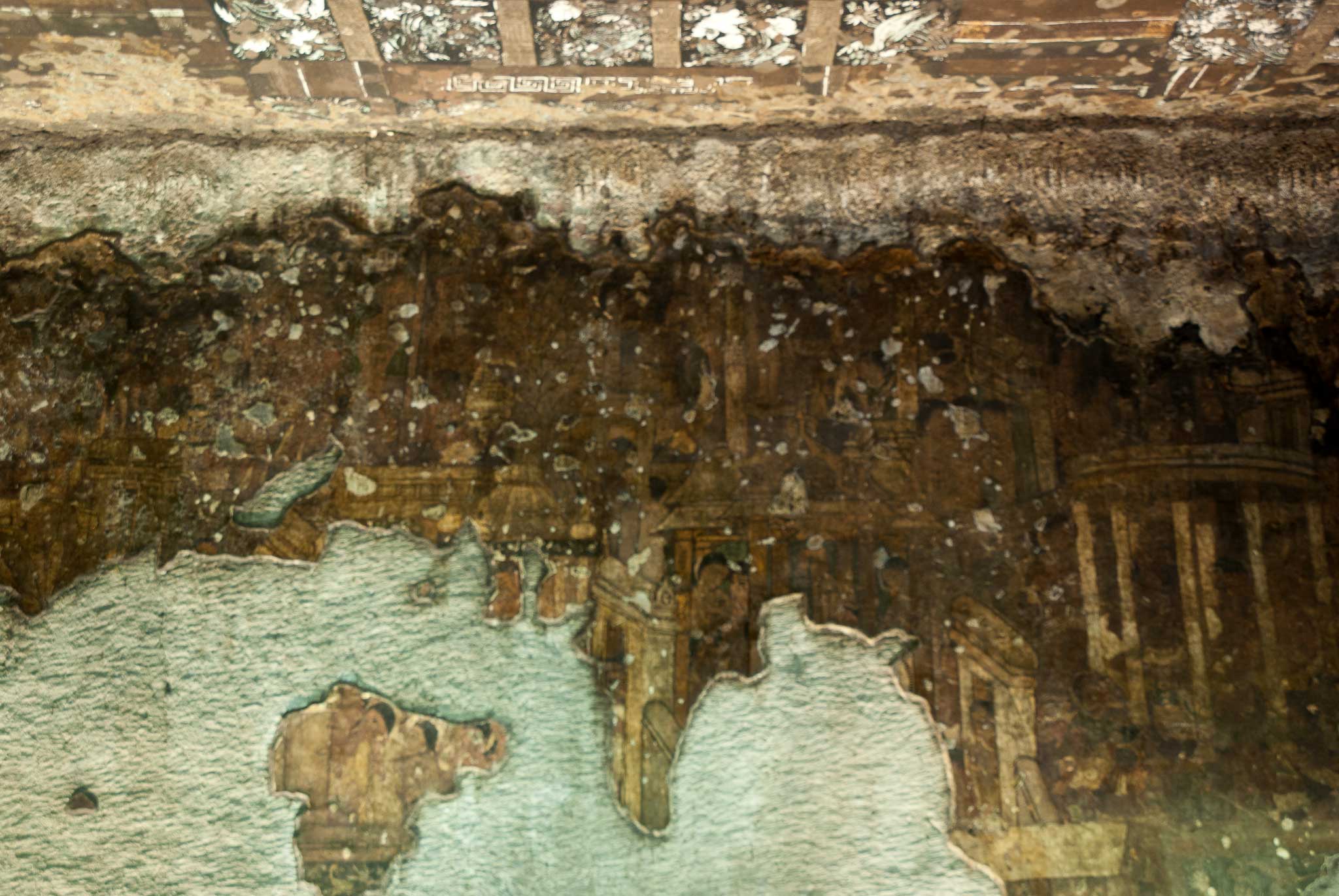Cave No. 16
Identification: episodes 1–5, 8–15, 19–20, 23, 25, 28–29, and 31 by Schlingloff (1983, p. 119–122, 127–131, 135–136, 140, 142–144, 146), episodes 6 and 7 by Yazdani (III, 1946, p. 67, 167), episodes 16, 18, and 24 by Burgess (1879, p. 60 f.), episode 17 by Griffiths (1896, p. 33), and episodes 21–22, 26–27 and 30 by Foucher (1921, p. 224–225). The legend is from the life of the Buddha.—
The Bodhisattva chose Māyā, King Śuddhodana’s wife, for his last rebirth in Kapilavastu. In the midnight hour, the Bodhisattva entered Māyā’s womb in the form of an elephant. Māyā saw four dreams relating to this, which she narrated to the king. On the king’s request, the brahmans explained to the queen that she would give birth to a son who would become either a universal monarch or an enlightened Buddha.
At the time of delivery, Māyā expressed her desire to visit her father’s place, Lumbinī, where she went with her retinue of maids. She clung to an Aśoka tree to give birth to the Bodhisattva. After the birth, the Bodhisattva took seven steps in four directions and announced his redemption. After the Bodhisattva’s birth,successors of a neighbouring kingdom were born. Then the Bodhisattva was taken to a yakṣa temple. A foster-mother was entrusted to look after the child. The brahmans and experts recognised 32 signs of a great personality and predicted that the child would become either a great emperor or an enlightened Buddha.
One week after the Bodhisattva’s birth, the queen died and was reborn in Indra’s heaven. Saint Asita, escorted by Śuddhodana, saw the sleeping child with open eyes and heard the prophecy of the brahmans from the king.
The Bodhisattva demonstrated amazing strength by holding a food bowl against 500 elephants. His teachers found that he already knew all the scripts. Further, he showed the Brāhmī script, which became known at the appearance of the Buddha. Everybody was surprised by his strength and skills. He flung away a dead elephant killed by his cousin, Devadatta. He broke thick bamboo smoothly and shot seven palm trees with a single arrow. The Bodhisattva married Yaśodharā, the daughter of the Śākya Daṇḍapāṇi.
When the water management system was disrupted by a massive tree, which fell into the river, the Bodhisattva helped to lift and remove the tree. He healed a goose wounded by Devadatta’s arrow and released him. In the same outing, a youth, Udāyin, killed a snake which was about to attack the Bodhisattva. Udāyin turned black and was thus called Kālodāyin (Black Udāyin). On his return, people noticed the chemistry between the Bodhisattva and a girl, Gopikā, and informed the king about it. The king suggested that the Bodhisattva wed Gopikā.
Once the Bodhisattva, accompanied by his charioteer saw an old man, a sick man, and then a funeral procession. On his fourth outing, he saw a monk. The king tried to divert the attention of the prince and asked the Bodhisattva to inspect a village of the royal estate. He saw a pitiful sight there and sat under a rose-apple tree to meditate and completed the first degree of contemplation. In the evening, the shadow of the tree had not left the Bodhisattva’s body uncovered. Seeing this miracle, the king bowed in front of his son, returned to Kapilavastu and told his brothers about the brahman’s prophecy.
The king and his brothers kept a watch over the prince but the Bodhisattva’s mind was set on renouncing the world. When his wife became pregnant and he saw the ugliness of the exhausted court ladies in their quarters, he left the city under the cover of night on instructions from Indra, Brahmā and other gods. The Bodhisattva met Saint Bhārgava, who welcomed him, but he moved on. He crossed the river Ganges and reached Rājagṛha, collected food in his bowl, begging from house to house. King Biṃbisāra noticed him and asked him the reason for renouncement. The Bodhisattva explained the reason and promised the king that he would visit his palace after achieving enlightenment.
When the Bodhisattva moved to Gṛdhrakūta, he realised that his path to redemption was not the right one. He met two yoga teachers, Ārāḍa Kalāma and Udraka Rāmaputra, but he was not satisfied. He started practising extreme asceticism. He remembered his first meditation exercise and understood that he was on the correct path. Once, he visited a village, where the maidens had made a special milk-pudding for the Bodhisattva. The ascetic, Upaga, wanted to taste this pudding but the maidens refused to give it to him. When the gods arrived, the maidens wanted to know who had the highest rank. The gods named the Bodhisattva. Two maidens went to the Bodhisattva and offered him the pudding. This was his last meal before he became the Buddha. When Upaga asked him about his teacher, the Buddha informed him that he had attained enlightenment without a teacher. Then he headed for Benaras to preach his sermon.
—Source: Singh 2019, 31-33; Schlingloff 2013, I, 41-43








